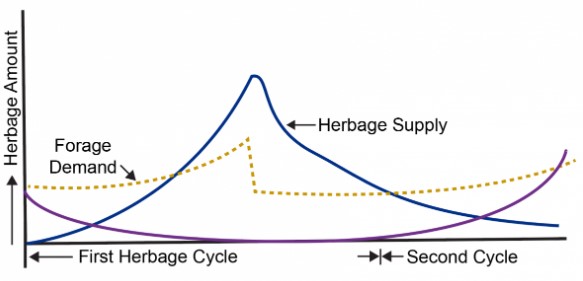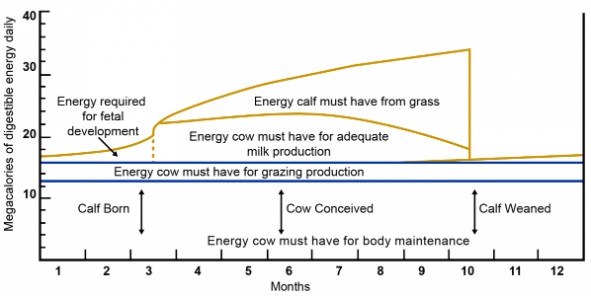By Ken Olson
Choosing the calving season is a complex and highly individual decision for each beef cattle producer. This leads to a wide range of calving seasons across the Northern Plains. Various factors affect this decision, with a few of these being facilities, resources, other enterprises, time commitments and finances. This article will focus on nutritional resources.
Forage Supply and Demand
A primary consideration in pasture-based cow-calf operations is choosing a calving season that will best match the forage supply to forage demand. In general, forage production and quality is high in the spring with the peak occurring in early summer and then supply and quality decline through the remainder of the year as forage matures (Figure 1). The question becomes: Do we match this peak in nutrient supply to the peak in demand by the cows or by the calves?

Figure 1. Matching nutrient supply from forage with nutrient requirements.
Matching the nutrient supply from the forage with nutrient requirements of the calf tends toward late winter to early spring calving. This is because calves that are older and more functional ruminants will be more capable than younger calves at utilizing grazed forage at its peak nutrient quality in early summer.

Figure 2. Seasonal energy requirements of the beef cow and calf.
This would mean that the peak for the energy the calf must have from grass in Figure 2 would coincide with the peak herbage supply in Figure 1. When matching the calf nutrient supply with the forage, the intent is to wean older, heavier calves. However, there are disadvantages that need consideration. The major one is that it can be difficult to manage cow body condition score during late pregnancy and early lactation when calving occurs months before green grass will be available. If cows lose body condition during this period, reproductive performance will probably be reduced. Extensive use of harvested feeds will likely be required to maintain cow body condition, increasing annual cow costs. Another disadvantage is increased morbidity and mortality of newborn calves due to cold, wet wintry weather. Cows in lower body condition produce poorer colostrum and calves are cold-stressed, both of which increase potential for scours and other calf ailments.
Matching nutrient supply from the forage with nutrient requirements of the cow tends toward late spring calving. This would mean that the peak for the cow, which occurs approximately 2 months after calving in Figure 2 would coincide with the peak herbage supply in Figure 1. The advantage is that this matches peak nutrient demand of the lactating female with peak nutrient quality of grazed forage. The major disadvantage is that calves would be younger and lighter at weaning. It may be necessary to change weaning management and calf marketing strategies or timing to account for lighter weight calves.
Season Selection and Performance
USDA ARS scientists at the Ft. Keogh Research Station near Miles City, Montana conducted a study to compare cattle performance and economic response to February, April, and June calving seasons. February- and April-born calves had similar birth weights, while June-born calves were heavier at birth. This suggests better cow nutrition during late gestation for summer-born calves. These birth weights in June were in the normal range and did not cause an increase in dystocia. Weaning weights at a common weaning age (190 days) were reduced as calving season was delayed from February to June, but the difference between February and April-born calves was less than might be expected (485, 472, and 440 lb for February, April, and June, respectively). Another important response was that death rate in February calves was 6% but it was only 2% for April- and June-born calves. The cows were fed to maintain similar BCS, with the response of interest being the amount of feed required to meet this goal. As expected, the amount of feed required was greater for earlier calving. Despite feeding these higher levels, cows that calved in February and April still lost body condition in late pregnancy, while June-calving cows did not. Pregnancy rate did not differ among calving season groups.
Using the amounts of harvested feed reported in the Miles City study for cows in each calving season and applying current (fall 2020) South Dakota feed prices to those amounts of feeds, the savings in feed cost because of later calving was about $110 per cow per year (harvested feed costs were $185, $180, and $70 for February, April and June calving cows, respectively). Additionally, we calculated gross income per cow from calf sales based on the differences in weaning weights and calf crop percentage in the Miles City study using prices from market reports during the 2020 fall calf run at the Fort Pierre Livestock Auction. Gross income averaged $20 more per cow in the April and June calving seasons than the February calving season (gross income per cow was $614, $632, and $637 for February, April and June calving seasons, respectively). This was due primarily to the higher death loss in the February-born calves. If one considers that harvested feeds are the highest variable cost of a cow-calf enterprise, we can calculate that gross income over harvested feed costs favors later calving (net return over harvested feed costs was $429, $452, and $567 for February, April and June calving cows, respectively). Realize that this example should be adjusted for the unique characteristics of each individual operation based on cost and availability of feeds and income potential in chosen market outlets.
The Bottom Line
The obvious conclusion to draw is that late-spring calving has advantages over winter or early-spring calving. First, the perceived improvement in pounds of weaned calves from earlier calving is not likely to to be as great as is often assumed. Second, late winter feed costs for lactating cows are dramatically higher than for dry, pregnant cows, increasing feed costs to support a winter-calving cow herd. Adjusting the calving season is one of many alternatives to manage nutritional requirements and feed demand by a cow herd. However, just because late-spring calving fits forage supply with nutrient demand doesn’t mean that it is the best option for your system. As stated at the beginning, other factors affecting the operation need to be considered before a system-altering decision such as changing calving dates can be made.
Source : sdstate.edu